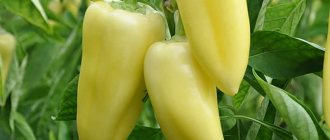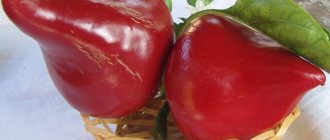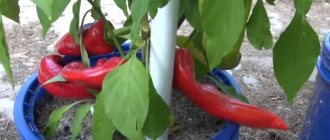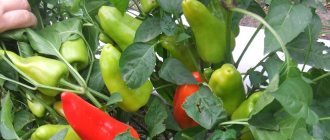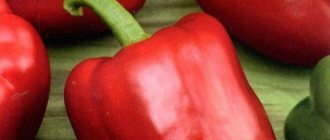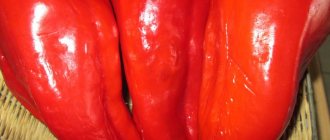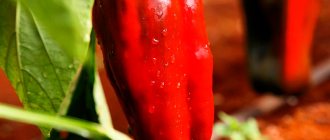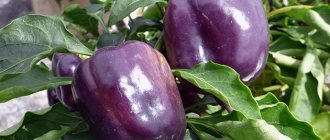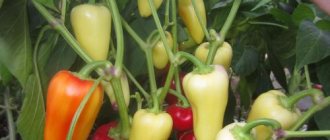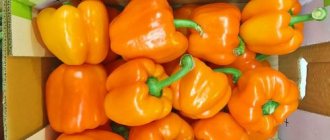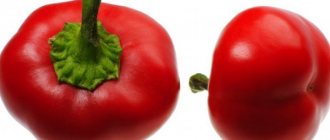Review: Sweet pepper seeds Seeds Ukraine “Bogdan” - Wonderful pepper!
Summer is over, and with it the harvesting of vegetables from our summer cottages.
It is already possible to sum up which varieties have pleased us with the harvest, and which species should be said goodbye. Today I will talk about a wonderful variety of sweet pepper “Bogdan”. I planted 3 varieties this season, and all the seeds were .
What pleased and surprised me most was the Bogdan variety. (in the photo the top of the bag is cut off when opening)
On the back of the bag there is brief information about planting and characteristics of the variety, so I will not dwell on these issues in detail:
I bought the seeds through the online store of this company in December 2014. The order was fulfilled very quickly.
The price at that time was 1.50 UAH. (4.10 rubles). The bag contains 0.3 g of seeds. Now this product can be purchased there for 2.70 UAH (7.40 rubles).
The germination of the seeds was excellent, and the seeds themselves were nice, not small, and clean. The seeds were fresh, the date of manufacture (2014) and the date of use (until 2018) were indicated on the packaging.
The package also contains all the manufacturer’s details: address, phone numbers, email and website address. This inspires confidence, since you often see packages without any identification marks.
Based on the results of cultivation, I can say that the grown pepper complied with the declared parameters.
The pepper was simply beautiful! If you have bought imported peppers in supermarkets, then you can imagine this pepper: it is just as big, everything is as smooth as a selection, shiny, thick-walled, in general - a sight for sore eyes!
Unfortunately, I have photos of not the best specimens, because at such moments you usually don’t think about taking photographs - you’re busy with gardening).
This is already at the end of the season, small specimens of pepper. At the height of the harvest, the peppers were much larger:
It not only looks attractive, but is also very tasty. The pulp of the fruit is fleshy, the walls are thick and the pepper tastes very aromatic.
The great advantage of this variety is its immunity to diseases. This variety did not bother me at all with any diseases or pests.
Although they write on the package that the variety is early-ripening, for me it still turned out to be mid-ripening, but it also produced a harvest in the fall. And new buds appeared all the time.
There was a lot of ovary on the bush, and there were also quite a lot of peppers, especially considering its size.
In the initial stage, unripe peppers are rich green in color and the fruits do not hang down, but are located with their nose up:
At the stage of biological maturity, it acquires a rich yellow-orange color:
I really liked this variety, I collected seeds from a beautiful fruit and intend to grow it next year, which is what I wish for you too!
Characteristics and description of pepper varieties Victoria, Ivanhoe, Tenderness, Blondie, Health
Victoria pepper is often chosen by vegetable growers for planting on their plots of land. The variety is characterized by early ripening of juicy and sweet fruits, and there are other positive characteristics. In addition to this species, other varieties are also popular.
Record holders in terms of ripening
Vegetable growers can choose early varieties of peppers for planting in a greenhouse or open areas of land. The characteristics and description of each selected type will help you make the right choice.
Pepper Zdorovya is not a very compact plant, reaching a height of up to 170 cm. It does not tolerate cold well, but is able to grow even in insufficient light. For these reasons, it is best to plant in a protected location. Super-early ripening allows you to harvest a large harvest already on the 90th day. Elongated fruits up to 11 cm weigh 45 g.
Blondie pepper F1 begins to enter the maturity stage after three months. The average weight of light yellow, cube-shaped vegetables is 150 g. This is a productive hybrid that is rarely susceptible to infections and thrives in the cold.
Boneta pepper is distinguished by its uniform yield after 88 days and tolerates drought. Suitable for growing in open beds. The bush is small and compact. Ripe vegetables are red in color, directed upward, shaped like a prism, weigh 150 g.
Buratino pepper begins to ripen after 90 days. A spreading bush with a semi-determinant type of growth reaches a height of 80 cm. Numerous large, elongated fruits weigh from 70-110 g. It is characterized by average resistance to blossom end rot and the tobacco mosaic virus.
Lotta pepper allows vegetable growers to harvest the first harvest after 2.5 months. The plant is resistant to major diseases, but is demanding of heat, light and moisture. The length of the red cone-shaped fruits is 12-14 cm, weight 115 g.
Hannibal pepper is characterized by a short period of formation of ripe fruits (from germination to ripening, an average of 88 days pass). The bush is small, semi-spreading. The fruits are prism-shaped, brown-violet in color, weight 100-140 g.
Red Knight F1 is characterized by early ripening, as it enters the maturity stage already on the 65th day. The tall bush bears numerous large cube-shaped fruits. The vegetable exhibits resistance to many diseases and quickly adapts to various conditions. Does not tolerate low light well, begins to stretch out and shed ovaries.
The early variety Kuzya is a low-growing plant, the height of the bush is only 35 cm. It does not take long to wait until the harvest ripens, 90-95 days. Prism-shaped fruits most often weigh 80 g. It is best to grow in a greenhouse or on a windowsill.
Gardeners begin harvesting Dolce Italiano after 90 days. The plant is tall and produces few side shoots, which makes caring for the crop easier. Large, elongated vegetables (up to 18 cm long) in the shape of a cone can weigh up to 200 g.
Fakir pepper also has early ripening periods (90 days). The height of the semi-spreading bush is about 65 cm. The fruits in the form of a narrow cone weigh about 45 g. The plant is rarely susceptible to disease and will delight vegetable growers with high yields.
A mature harvest of Early Miracle peppers can begin to be harvested after 93 days. The bush is compact with an indeterminate growth pattern. The stem stretches up to 120 cm in height. The fruits are in the form of a prism 15 cm long, their weight can reach 250 g.
Variety of early vegetables
Pepper Chanterelle will delight you with the first harvest after 105 days. The bushes are compact, take up little space, and are low-growing. Small fruits at the ripe stage are orange in the form of a cone, weighing approximately 40 g. The hybrid does not tolerate cold well, so it is recommended to grow in greenhouses and hotbeds.
Bogdan pepper is an early ripening plant. Approximately 100 days pass from the moment of germination. The height of the bush is approximately 55 cm. Yellow-orange vegetables of an elongated shape (length approximately 14 cm) weigh about 220 g. They rarely get sick and tolerate drought well.
Apollo pepper is an early-ripening hybrid for open ground and greenhouses. It reaches a height of up to 55 cm. Productivity is high; up to 14 prism-shaped red-orange fruits are formed on one bush, weighing about 170 g.
Pepper Nafanya enters the ripening stage already on the 95th day. The bushes are compact with a semi-determinant growth pattern. The height of the stem is about 120 cm. Bright burgundy vegetables with three sides can weigh 150 g. The variety is resistant to various adverse conditions and diseases, the harvested crop is stored for a long time.
Viking pepper allows you to harvest in 108 days. The height of the compact bush is small; the branches can accommodate up to 4 prism-shaped fruits, weighing approximately 200 g. The vegetable is resistant to viruses and bacteria, especially tobacco mosaic. The plant is unpretentious and adapts to any conditions, so the variety is suitable for open ground.
Agapovsky pepper belongs to the mid-early vegetables (100 days pass from the moment of germination). Compact bushes have a lot of foliage. The Agapovsky variety is characterized by high yield, rarely gets sick and is attacked by pests.
The disadvantage of the Agapovsky variety is poor shade tolerance; in this case, the bushes quickly wither. It is imperative to organize the correct watering regime. The Agapovsky variety can be planted in both protected and open beds.
The Agapovsky vegetable produces prism-shaped fruits about 12 cm long and weighing 115 g.
Capsicum pepper is a productive, early-ripening species. The bush is spreading and can reach a height of up to 120 cm. Cylindrical vegetables can weigh up to 250 g.
Description of the pepper variety Lyubov F1. Does not require special care, quickly adapts to various unfavorable conditions. From the moment of emergence of seedlings to the beginning of ripening, only 85 days pass. Bush, up to 65 cm high, compact, powerful, slightly spreading. Conical-shaped sweet vegetables up to 18 cm long weigh 150 g.
Vegetables of the Red Baron variety enter the stage of ripeness after 98 days and show resistance to the tobacco mosaic virus. The bush is of medium height, not very spreading. The fruits are in the form of a cube, weighing about 200 g.
Zorka pepper can be harvested on the 95th day. The plant is short (45 cm), weakly branched, unpretentious, resists infections well, and is therefore suitable for open ground. The vegetables are large, prism-shaped, red-orange in color, weighing about 110 g. Numerous crops begin to ripen together.
Vedrana pepper is a medium-sized, semi-spreading plant. It begins to bear fruit after 95 days. The fruits are large, cube-shaped, red-scarlet in color, weight 190-230 g. Vegetable growers note that the hybrid rarely gets sick.
Mid-early terms
You will be able to try sweet pepper varieties with mid-early boundaries only a couple of days later.
Description of the type of sweet pepper Victoria. Sweet pepper Victoria begins to ripen after 112 days. It tolerates low temperatures well, resists many common infections and will delight you with a rich harvest.
The cone-shaped fruits become deep red in color, their length is about 11 cm, and their weight is 60 g.
Reviews indicate that this type of vegetable can be planted without fear not only in a greenhouse, but also in open areas.
Pepper Tenderness is characterized by mid-early fruit ripening, approximately 118 days pass from the appearance of the first shoots. The bush is not too spreading, reaching a height of about a meter.
It is recommended to grow in protected soil. The weight of mature, red vegetables is approximately 110 g, pyramidal shape, length 11 cm. The plant resists many diseases, including tobacco mosaic.
Samander pepper is distinguished not only by its early ripening of fruits, but also by its high yield. The bush is low and compact. It tolerates bad weather conditions well; the leaves are protected from sunburn by thick skin. Dark red vegetables have an elongated shape with a pointed end and weigh 110 g.
The mid-late pepper hybrid Aristotle F1 tolerates various weather conditions well. The height of the powerful, leafy bush is approximately 70 cm. The cube-shaped fruits can weigh about 200 g. The hybrid has good immunity, so it rarely gets sick.
Marconi pepper is characterized by medium-early harvest ripening (110-115 days). Sweet fruits of an elongated shape (about 25 cm long), pointed at the end, weigh on average 170 g. Feels great in open beds. The height of the powerful stem is approximately 60 cm.
The early species include Ivanhoe pepper. Juicy, red fruits, weighing 110-150 g, begin to turn red after 115 days. The yield of this variety is very high. Ivanhoe pepper does not tolerate cold well; the soil should always be warm. Therefore, it is better to plant in a greenhouse.
Ivanhoe pepper has a long list of positive aspects. Even dense planting of seedlings will not reduce high yields. In the description of Ivanhoe pepper, it is worth mentioning the juicy and aromatic fruits, even in a semi-ripe state. The harvested crop is suitable for long-term storage and transportation over long distances. The Ivanhoe variety rarely gets sick and is attacked by pests.
Source: https://dachamechty.ru/perets/viktoriya-ajvengo-nezhnost-blondi.html
Description of the variety, reviews, photos
An early-ripening, large-fruited variety of bell pepper. Recommended for growing in open ground and film shelters. The period from germination to the beginning of ripening is 97-100 days.
The bush is semi-standard, 55-65 cm high.
Fruit characteristics
The fruits are cone-shaped, yellow-orange at maturity, weighing 200-250 grams, 12-15 cm long, 8-9 cm in diameter, with faint edges, juicy, sweet, without bitterness, with delicate skin. Wall thickness 6-8 mm. This pepper is perfect for fresh consumption and canning.
The productivity of the variety is high.
Sweet pepper Bogdan is not included in the State Register of the Russian Federation.
Features of cultivation
Peppers are grown through seedlings. It is recommended to sow seeds 70-75 days before planting in a permanent place. Sowing depth is 2 - 4 cm. The optimal temperature for seed germination is 26-28°C.
When true leaves appear on the plants, they are transplanted into separate cups with a capacity of 0.3-0.5 liters.
Pepper does not like transplanting, so do not be surprised if after you have transplanted the seedlings into separate containers, they stop growing for a while. You can “smooth out” the stressful state a little by spraying the plants with Epin.
When to plant pepper seedlings in the ground
After the threat of return frosts has passed, the seedlings can be planted in a permanent location. Some people plant in open ground in May, while others only plant under covering material or under film; it all depends on the climatic conditions of your region.
When planting pepper seedlings in the ground for 1 sq. m it is recommended to place up to 6 plants, no more. Planting pattern 35 x 40 cm.
Further care consists of timely watering, fertilizing and loosening the soil. The pepper is planted in the ground without deepening it, but in exactly the same way as it grew in cups. Pepper plants, unlike tomatoes, very rarely produce lateral roots, so there is no point in deepening them.
Preparation for cultivation
Manufacturers often treat Bogdan seeds in the factory . This planting material is painted green or orange. Processing information will be indicated on the packaging.
If the seeds are not processed at the factory, then gardeners do this at home. Preparation of planting material includes the following points :
- Checking seeds for germination . They are soaked in a salt solution prepared from 1 tsp. salt 1 glass of water. After half an hour the result is checked. The germination of seeds that have not sunk to the bottom is questionable. They are not used for sowing.
- Disinfection of planting material . The seeds are soaked in a light pink solution of potassium permanganate for half an hour, hydrogen peroxide for 15 minutes, or in a soda solution (1 teaspoon per 1 glass of water) for 12 hours. After that, they are washed under running water.
- Growth stimulation . The seeds are soaked in a nutrient solution (Epin, Zircon, aloe juice) or germinated in advance. In the second case, the planting material is wrapped in cloth soaked in warm water. Seeds in fabric are placed in a deep container, covered with film and put in a warm place until they hatch. All this time they are moistened with warm liquid as they dry.
Advice! Many gardeners prepare their own growth stimulant. To do this, add 1 tsp to a glass of warm water. ash and the same amount of superphosphate.
Pepper soil is sold in gardening stores. It is not necessary to buy a specialized mixture for tomatoes and peppers; universal soil will do.
Prepare the soil mixture yourself . The simplest option is to mix equal proportions of humus, garden soil and sawdust.
Other varieties of yellow pepper:
Early ripening and high-yielding hybrid of pepper "Kalif"
Pepper variety "Big Mama" with juicy sweet fruits
Pepper “Siberian Bonus” with bright and tasty fruits
The soil for seedlings must be disinfected . This is done in one of the following ways:
- put in a container with holes and pour boiling water over it;
- pour over a dark pink solution of potassium permanganate or hot copper sulfate;
- baked in the oven.
peppers immediately in individual cups . This plant does not tolerate picking well. It is better to use peat containers, from which you do not need to remove the seedlings.
If you plan to sow a large number of seeds, then use boxes . When the seedlings grow, they are planted in individual pots with a volume of 300-500 ml. All containers are treated with a dark pink solution of potassium permanganate.
To grow seedlings you will need drainage . Coarse river sand, small crushed stone, crushed ceramics, expanded clay or brick are suitable. This filler is also treated with a disinfectant solution.
Basic mistakes when growing sweet peppers, video
In this video you will learn how not to make mistakes when growing this delicious vegetable. What you need to pay attention to when planting, replanting peppers and much more.
If you grew Bogdan sweet pepper, please write whether you liked this variety or not. What was the yield under your climatic conditions? How do you rate the disease resistance of this variety? If possible, attach a photo of the pepper you grew to your comment. Thank you!
Your reviews of Bogdan pepper and additions to the description will help many gardeners evaluate this variety more objectively and decide whether it is worth planting or not.
Description and characteristics of the variety
Bogdan pepper is an early-ripening variety of bell pepper and has large, sweet fruits. It can be grown both in open ground and in greenhouses. The bush is semi-standard with a height of 50 to 65 cm. The time required for seedlings to grow and fruits to ripen is about 100 days. Despite all the advantages, this pepper variety is not included in the Russian state register.
History of the Bogdan variety
The Bogdan pepper variety has Ukrainian roots and was bred by the Soyuz joint venture at the Dnepropetrovsk Agricultural University. The variety is not a hybrid. This is the result of many years of planned selection with the gradual consolidation of the necessary economically valuable traits. Thus, if you bought seeds and grew a good, large and sweet pepper, you can collect new seeds from your harvest, selecting the most successful specimens.
Reviews
Reviews from gardeners about Bogdan are mostly positive . Those who have tried this hybrid say that they will grow it again:
Alisa, Izhevsk : “I grew Bogdan in a greenhouse for 2 years. A very large-fruited and beautiful hybrid. The fruits are beautiful, just like in the photo. The taste is rich, sweet, ideal for lecho. I plan to grow it more than once.”
Oleg, Sochi : “I grow Bogdan in open ground at the dacha. Pepper is unpretentious. I water it twice a week, and that's enough for him. Never got sick. Stepsonning is also not necessary. I prefer to tie up the bushes, it makes me feel calmer. The fruits are very tasty and large.”
Advantages and disadvantages of the variety
- The undoubted advantages of the variety include:
- early ripening and early ripeness;
- long fruiting;
- high productivity (up to 1 ton of crop can be harvested from one hundred square meters under good conditions);
- high content of beta-carotene and vitamin C in fruits;
- increased fruit set;
- resistance to various diseases;
- excellent taste and versatility of fruit use.
As for the disadvantages, it should be noted that pepper is whimsical as a garden crop: both excess and lack of minerals, moisture, and sun are equally harmful to it.
- For example:
- With a lack of potassium, the leaves dry along the edges and curl into a tube.
- If the pepper does not have enough nitrogen, the leaves turn gray and gradually degenerate, and an excess of the substance will lead to the falling of flowers.
- A lack of phosphorus will cause the undersides of the leaves to turn purple.
- The “marbled” color of the leaf indicates that the plant needs magnesium.
- Excess watering leads to putrefactive disease, lack of watering leads to drying out of the roots.
Growing and care
The bushes are planted in the beds within 60–65 days. The variety is suitable for cultivation in open soil in different types of greenhouses. Important conditions: good lighting of the site and high-quality soil aeration.
The medium-sized variety needs shaping and pinching.
Water with settled water and feed up to twice a month. Monitor plants and adjust fertilizers:
- with potassium deficiency, the leaves dry out along the edges and curl up in a tube;
- with a lack of nitrogen, the leaves turn pale, acquire a grayish tint, and the green mass grows weakly;
- if there is little phosphorus, the lower surface of the plates becomes purple;
- A lack of magnesium contributes to the appearance of a marbled tint.
Features of growing crops
This variety is grown using seedlings. 2–2.5 months before the intended planting in the ground, the seeds are planted on seedlings.
Seed preparation
The seeds are planted 2-4 cm deep, the distance between them is about 2-3 cm. It is best if the air temperature is not lower than 25 degrees and not higher than 28. It is necessary to immediately maintain the required planting depth, because in the future the depth will change when picking or replanting can lead to rotting or drying out of the root system.
Selection of containers
When planting, you can use a box filled with soil. As soon as the first full leaves appear on the seedlings, the seedlings can be planted in separate cups (0.3 or 0.5 l).
Soil requirements
Before sowing, the container is half filled with loamy soil and compacted well. The soil should be moist. Having arranged the seeds according to the pattern, they are sprinkled with another 5 cm of soil and compacted again.
Seedling care
There are special water-soluble mineral fertilizers for feeding seedlings. It is best to apply them along with watering. Water the sprouts with warm, settled water.
When two true leaves appear, it is advisable to feed the seedlings with the following solution: 0.5 g of ammonium nitrate, 1 g of potassium fertilizer and 3 g of superphosphate mixed in 1 liter of water. The next feeding is carried out after two weeks, with a double dose of mineral fertilizers.
From time to time, you can feed the seedlings with nettle tincture (take 2 parts of nettle to ten parts of water, mix and leave for several days). It is useful to do this fertilizing 2 days before planting in the ground.
Transplanting seedlings into the ground
If enough time has passed since the seeds were planted, make sure that late frosts have passed, and then you can safely plant the seedlings in a permanent place. Depending on the region, you can plant it in open ground as early as May or place it under a covering film.
Early varieties of sweet pepper also include:
The Bogdan variety loves warmth and moisture; it is better to plant it on the leeward side in sunny areas. When planting, fresh organic fertilizers are contraindicated; they reduce the yield and quality of the fruit.
The planting pattern is 35x40 cm. It is best if no more than 6 plants are placed on each square meter of the garden. Since pepper does not produce lateral roots, there is no point in burying it in the ground. The same planting depth as in the cups is sufficient.
Landing
Sowing is carried out from February to March. Sequence of seed processing for better germination:
- Soak in 1% saline solution for discarding.
- Disinfect with fungicide or potassium permanganate.
- Keep in damp gauze for up to 2 days.
For seedlings, use a loose turf-compost substrate (from the store or from the dacha). The soil is spilled with boiling water a week before planting and irrigated with 1% Fitosporin.
Seedlings are cared for traditionally: watered, fed, pruned in the phase of 1–2 leaves.
Caring for the plant after transplanting into the ground
Pepper needs loamy, breathable soil. The best predecessors are legumes, cabbage and cucumber. After them, the vegetable gives the highest yield. Care consists of timely watering, fertilizing, weeding the beds and tying up the trellises.
Watering and fertilizing
Mineral fertilizing is necessary throughout the entire growing season. They are usually added during watering. Watering is carried out in the evening, the water should be warm (about +30°C).
From the moment the seedlings are planted in a permanent place and before fruiting begins, it is advisable to feed the peppers at least 3-4 times with chicken droppings. It is good to alternate these activities with foliar mineral supplements, for example: a tablespoon of nitrophoska per bucket of water.
Hilling and loosening the soil
To enrich the soil with oxygen, loosening the soil around the sprouts is considered mandatory at least once every few weeks. Then you can carry out hilling and mulching. Peppers benefit from mulching with rotted straw.
Laying a layer 10 cm thick will help retain moisture in the root zone longer and reduce the frequency of watering. After completing all these procedures, the pepper trellises can be tied up.
Plant Formation
On especially hot and humid days, it is useful to plant Bogdan pepper. This activity involves pruning the side shoots, especially those located at the bottom of the stem. This procedure is not recommended in dry, hot weather.
If you carefully study the advice of experienced gardeners, you will notice that they agree on one thing: the first flower that appears on the plant must be removed. This makes the crop more productive.
The growing season is accompanied by frequent pruning of particularly long shoots to avoid shading. All shoots located below the main branch on the stem are also removed. Pruning is carried out every 10 days and after harvesting. You can combine these procedures with loosening and hilling the soil.
Growing seedlings
Peppers in our country are grown exclusively by seedlings . Then the crop will have time to ripen before the onset of frost.
seeds for seedlings 70-80 days before the intended planting of pepper in a permanent place . Typically, seedlings begin to be grown at the end of February or March.
Planting pepper
2 days before sowing the seeds, the soil is brought into a warm room and allowed to warm up. Then the prepared containers are filled, having previously poured a layer of drainage on the bottom.
To sow seeds in a common box, grooves are made in the soil, 2-4 cm deep. A gap of 3 cm is left between the rows. Seeds are sown in depressions at a distance of 3 cm.
When growing seedlings in individual containers, 1-2 seeds are sown in each pot. They are buried 2-4 cm.
Note! Sow 2 seeds in one container so that at least one seed germinates. If 2 plants appear in 1 cup, then the weaker stem is pinched when 2 true leaves appear. Bogdan's planting material has a high (almost 100%) germination rate. Therefore, many gardeners sow 1 seed in each pot.
The seeds are sprinkled with soil and the soil is watered. Containers with crops are covered with film and put in a warm place.
Every day the film is opened slightly for 30-60 minutes for ventilation . The soil is watered with a spray bottle as it dries. The appearance of mold on the soil indicates too much watering. In this case, the affected layer is removed so as not to remove the seeds. The soil is sprayed with a light pink solution of potassium permanganate.
Further care
Healthy seedlings should be squat and strong with bright green leaves. To get such plants, you need to properly care for them :
- The film is removed after the first shoots appear. Plants are placed on a windowsill or under a fluorescent lamp. If seedlings are grown on a windowsill, then the containers are periodically rotated in relation to the window.
- Plants are planted in individual containers after the appearance of 2 true leaves (if the seeds are sown in a common box). Plants are watered before the procedure. When removing them from a common box, they are held by the leaves and helped with a fork. The root collar is not buried. This will cause the roots to rot.
- Pepper is sprayed with a spray bottle as the soil dries 2-3 times a week.
- When growing seedlings on a windowsill, it is important to ensure that they are not exposed to drafts. Otherwise, the plants will die.
- 2 weeks before picking to a permanent place, the pepper begins to be hardened. To do this, it is taken outside during the warm part of the day.
Seedlings are fed 3 times . Use the following scheme:
- The first time is 2 weeks after the appearance of 2 true leaves. For 5 liters of water take 20 g of superphosphate, 5 g of potassium salt and 10 g of urea.
- After 14 days, the seedlings are fed again. Add a mixture prepared from 5 liters of water, 20 g of ammonium nitrate, 30 g of superphosphate and 10 g of potassium salt.
- 5 days before planting, the last fertilizing is applied to a permanent place. Add 1 glass of ash and 25 g of superphosphate to 5 liters of liquid.
Disease and pest control
The most common diseases of bell peppers are late blight, black leg, and various types of rot. The Bogdan variety is resistant to these types of diseases and with proper care you may not even remember their existence.
Insect pests such as aphids, mole crickets, slugs, and the Colorado potato beetle pose a greater threat. A preventive measure helps against mole crickets: when planting seedlings, an hour before, the hole is first filled with water, and after planting, the plants are thoroughly sprayed. A tincture of wood ash can also protect peppers from pests. 3 sprays per season are enough.
If aphids appear on the leaves, you need to purchase a special serum and dilute it with water, and then treat the plants with this mixture. To consolidate the result, the leaves are sprinkled with finely ground wood ash.
